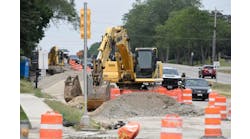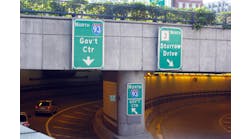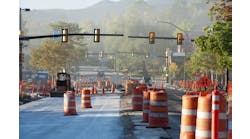The Delmar Loop in the historic urban core of St. Louis is experiencing a wave of revitalization thanks to the efforts of local business, government and community members working together to revive and renew the area, both physically and economically.
To further this revitalization effort, local leaders initiated the Delmar Loop Trolley project, which is bringing back the fixed-track trolley to Delmar Avenue and DeBaliviere Boulevard. With the return of the trolley, the Delmar Avenue area in University City and St. Louis is expected to see significant reinvestment and stabilization. Just as importantly, the project will demonstrate the successful melding of track work and trolley into an urban corridor and show how trolleys and traffic can share the road.
The East-West Gateway Council of Governments (EWGCG), the Metropolitan Planning Organization for the St. Louis area, has been at the forefront in creating livable, walkable, economically viable and sustainable communities. EWGCG is leading the development of the Delmar Loop Trolley as a “sustainable capstone” for the Delmar neighborhood. The CH2M Hill team was selected to plan and design the Trolley Loop as a multimodal showpiece combining both heritage streetcars and modern transportation amenities. The Delmar Loop Trolley will traverse a 2-mile route spanning University City and the city of St. Louis.
CH2M Hill is managing the planning and design of the adjacent streets, pedestrian amenities and the vehicle maintenance and storage facility for the Delmar Loop Trolley project. Other firms on the team include URS, which is providing civil design, roundabout and Americans with Disabilities Act (ADA) design; and Stone Consulting, providing track and overhead catenary system (OCS) design.
Making a street great
The Loop has its origins in the trolley lines that looped through the area in the first half of the 20th century. The new trolley will connect two light-rail transit stops, a major tourist destination in Forest Park, and the University City Loop with a single, greenhouse-gas-minimizing alternative for travel. It also will encourage urban infill development that will provide economic benefits for both the city of St. Louis and University City.
The project area encompasses both wealthy and economically distressed neighborhoods, a historic park and commercial development. Therefore, many of the project stakeholders have varied and sometimes competing interests in the project, such as station location and design; impacts on traffic both during construction and operation of the trolley; and effects on other modes of travel, as well as any associated transit-oriented development. Other key issues include potential impacts to the natural and historical environment of the park and enhancing the economic vitality of surrounding businesses with the addition of the trolley.
To ensure that alternatives were developed to properly address stakeholders’ concerns, the project team employed a context-sensitive-solutions process to define the environmental, economic and social context for the project. The team then coordinated with the project stakeholders to refine the context in which a range of alternatives were developed to address specific stakeholder concerns.
While many will see the Delmar Loop Trolley as the centerpiece of the project, consideration for land use and the streetscape will be just as important. As a “Great Streets” project, the Delmar Loop Trolley is not just simply a passage for trolley traffic, but will be functionally and aesthetically complete for all modes of traffic, vehicular and pedestrian. Typical of Great Streets, the project will provide a corridor that enhances multimodal mobility, safety and sustainability.
To meet these goals, the team addressed several challenges:
- Constructing a new trolley track in the existing roadway;
- Modifying the roadway to accommodate the trolley;
- Constructing station stops;
- Constructing an urban trail system for bikes and pedestrians;
- Renovating an existing historic building into a maintenance facility;
- Minimizing the relocation and adjustment of existing utilities;
- Providing on-street public
- parking; and
- Upgrading existing pedestrian facilities to current ADA standards.
The trolley is being planned and designed as a single track line running east-west on Delmar Avenue, within the existing vehicle lanes, starting at Kingsland Avenue in University City.
In addition to the trolley construction at the western project terminus, a roundabout is planned at the intersection of Delmar Boulevard and Trinity Avenue, addressing existing traffic congestion issues as well as calming traffic as it enters the trolley corridor.
At Des Peres Avenue, the trolley merges into a single-lane track that runs through the median, and turns south onto DeBaliviere Boulevard. At this point, the trolley leaves the roadway and travels along an area parallel to DeBaliviere, through a greenway that will be developed by eliminating two traffic lanes on DeBaliviere through a road diet, south to the Missouri History Museum in Forest Park. This grass-type track structure will allow the trolley tracks to blend into the greenway area. The streetcar will operate along the grassed portion of the greenway adjacent to the multipurpose path. A curb will separate the grassed area from the path. The multipurpose path and greenway are being developed in conjunction with the trolley project and are being administered by the Great Rivers Greenway District.
Trying to blend in
Consideration for how land use and streetscape will change as a result of the trolley’s return is a key factor in the project. The design team will ensure that the ultimate streetcar solution is seamlessly integrated with future land uses in the corridor.
To minimize impacts to the Delmar and DeBaliviere roadways and vehicular traffic that will ultimately share the road with the trolley, the team is designing a shallow track slab allowing the rail and pavement to be flush and thereby eliminating safety hazards for both cars and pedestrians. A number of other elements will minimize roadway impacts and enhance safety for vehicles, pedestrians and trolley passengers, including curb bulb-outs for station stops, reduced traffic speeds, the addition of lighting, signage, and banners, and traffic-calming treatments such as crosswalks, tabled intersections and speed humps.
The Loop Trolley Co. will operate the heritage trolleys, which will be heated, air conditioned and draw power from an OCS. The OCS affords cost-effective reliability of service and minimizes impacts to traffic through a constant source of power. The trolley system will use direct suspension overhead contact, which also minimizes aesthetic impacts with its less obtrusive design. Because it will operate at relatively low speeds (the speed limit on Delmar and DeBaliviere is 25 mph; the trolley will operate between 20 and 25 mph), the trolley will not need as much power and will be able to operate on a single wire. The CH2M Hill design team will incorporate visual reduction methods into the project aesthetics, such as light poles and trees.
The project has a total of 10 station stops along Delmar and DeBaliviere. Designed to be simple and easily incorporated into the existing roadways, the stations will be set at curb height, with crosswalks extended to meet trolley tracks, and with benches and a simple awning for shade/shelter at some locations. All stations and connections will be fully accessible and ADA compliant. The 10 station stops will directly serve key attractions or be within reasonable walking distance to destinations such as the Missouri History Museum, Forest Park, Crossroads College Preparatory School and the MetroLink Stations at Delmar and Forest Park Parkway. The stations also will enhance access to theaters, restaurants, offices and shopping opportunities with vibrant mixed-use and residential neighborhoods.?In keeping with the Great Streets philosophies (streets that are functionally multimodal contribute to economic vitality and sustainability, improve walkability and enhance quality of life), the project will include a 1?2-mile urban trail system for bikes and pedestrians. The trail, part of the Great Rivers Greenway’s St. Vincent Greenway, will run along the DeBaliviere corridor from Delmar south to Forest Park.
The other major element of the project is the trolley maintenance facility, which will be used to store and maintain the heritage vehicles. An existing building, constructed in the early 1900s, will be restored for this purpose. The facility originally served as an automobile sales and repair facility and is listed on the National Register of Historic Places. It had been used as Delmar High School until the mid 1990s and has been sitting empty since then. The two-story structure, built with limestone panels and large plate-glass windows, will undergo a historic restoration, in coordination with federal historic preservation guidelines and the Missouri State Historic Preservation Office, bringing the building back to its 1950 look and feel.
Like many urban and suburban areas, the St. Louis community has a goal to revitalize its urban corridors through multimodal solutions that are livable, walkable, economically viable and sustainable. Through careful planning and design, the Delmar Loop Trolley will be a catalyzing force for beneficial growth and renewal of a historic neighborhood, while demonstrating the viability of mixed trolley-automobile traffic.
Final design and engineering on the Delmar Loop Trolley will be complete by the end of summer 2012, with construction scheduled to begin as early as late 2012/early 2013. Trolley service could begin as soon as the spring of 2014. R&B


